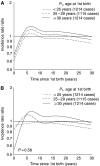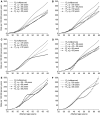Breast cancer risk by age at birth, time since birth and time intervals between births: exploring interaction effects
- PMID: 15597097
- PMCID: PMC2361726
- DOI: 10.1038/sj.bjc.6602302
Breast cancer risk by age at birth, time since birth and time intervals between births: exploring interaction effects
Abstract
In a Norwegian, prospective study we investigated breast cancer risk in relation to age at, and time since, childbirth, and whether the timing of births modified the risk pattern after delivery. A total of 23,890 women of parity 5 or less were diagnosed with breast cancer during follow-up of 1.7 million women at ages 20-74 years. Results, based on Poisson regression analyses of person-years at risk, showed long-term protective effects of the first, as well as subsequent, pregnancies and that these were preceded by a short-term increase in risk. The magnitude and timing of this adverse effect differed somewhat by birth order, maternal age at delivery and birth spacing. No transient increase in risk was seen shortly after a first birth below age 25 years, but an early first birth did not prevent a transient increase in risk after subsequent births. In general, the magnitude of the adverse effect was strongest after pregnancies at age 30 years or older. A wide birth interval was also related to a more pronounced adverse effect. Increasing maternal age at the first and second childbirth was associated with an increase in risk in the long run, whereas no such long-term effect was seen with age at higher order births.
Figures





References
-
- Albrektsen G, Heuch I, Tretli S, Kvåle G (1994) Breast cancer incidence before age 55 in relation to parity and age at first and last births: a prospective study of one million Norwegian women. Epidemiology 5: 604–611 - PubMed
-
- Albrektsen G, Heuch I, Kvåle G (1999) Joint effects on cancer risk of age at childbirth, time since birth and attained age: circumventing the problem of collinearity. Stat Med 18: 1261–1277 - PubMed
-
- Bernstein L, Depue RH, Ross RK, Judd HL, Pike MC, Henderson BE (1986) Higher maternal levels of free estradiol in first compared to second pregnancy: early gestational differences. J Natl Cancer Inst 76: 1035–1039 - PubMed
-
- Breslow NE, Day NE (1987) Statistical Methods in Cancer Research Vol. 2, The Design and Analysis of Cohort Studies. IARC Scientific Publications No. 82, Lyon: IARC - PubMed
MeSH terms
LinkOut - more resources
Full Text Sources
Medical

